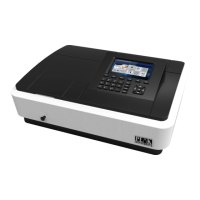I. Spectrophotometer Overview
1. Basic operating principle
1) The nature of absorption: spectrophotometric analysis method is the use of substances to choose a different
wavelength of light absorption characteristics established. Typically using a prism or grating to obtain
monochromatic light that passes through the continuous monochromatic solution, the solution was measured and
the absorption of each wavelength, the absorption spectrum curve obtained.
Absorption spectrum selective absorption of light from the material, which is the material of macroscopic phenomena,
and the nature of the molecular absorption is the result of internal movement and light interaction. When molecules
absorb certain wavelengths of spectral energy or by some wavelengths of the spectrum is absorbed to form the
absorption spectra. The smaller the energy absorption, the wavelength of light corresponding to the absorption peak at a
longer wavelength. When the infrared absorbent is formed in the infrared absorption spectrum, if the energy absorption
is larger, the shorter the wavelength corresponding to the absorption peak at a shorter wavelength, when generating the
ultraviolet absorption spectra of absorption in the ultraviolet region.
2) Absorption Law - Lambert Beer law: when a parallel beam through the homogeneous solution, the absorbance of
monochromatic light is proportional to the product of the solution concentration and thickness.
Its digital expression: A=KCL=LogI/I
0
=-LogT
Premise absorption laws established numeric expression: ① the incident light is monochromatic ② the
absorption process without interaction of each substance, the absorbance of each substance has additivity ③ the
role of light and matter is limited to the absorption process, no fluorescent and photochemical scattering
phenomena ④ absorbent system is a continuous uniform distribution
3) Impact spectrophotometry reasons:
A. Non-absorption errors caused by radiation and matter
B. Fluorescence and photochemical reactions, in general, errors fluorescence spectrophotometry produced
negligible fluorescence efficiency is very small in most cases the color system, and the fluorescence emission is
isotropic, only a small portion along the transmitted light direction into the detector, the measurement of
absorbance is low, resulting in a negative deviation. Depends on the instrument to measure the impact on the
absorption of fluorescence great extent on the optical absorption cell and detector design.
C. Reflection and scattering, absorption law applies only to homogeneous medium absorption system, turbid solution so
that the measured increase in absorbance due to scattering, resulting in deviation from Beer's law
D. Non-ideal instrument error caused
E. Beer's law deviation polychromatic contrast, the majority of the photometer can only get close to monochromatic light
with a narrow lumen, in fact, there is still a polychromatic nature, can lead to deviations from Beer's law. Deviation

